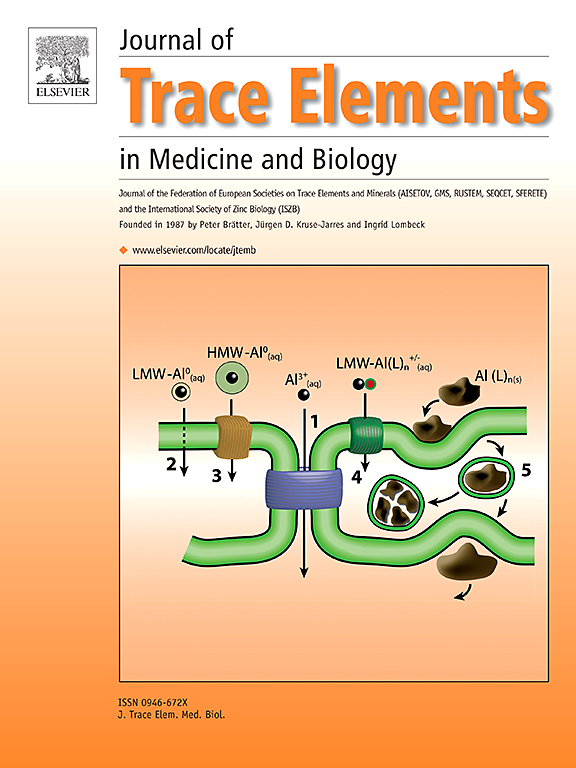重金属暴露与丙型肝炎病毒感染:一项横断面研究
IF 3.6
3区 医学
Q2 BIOCHEMISTRY & MOLECULAR BIOLOGY
Journal of Trace Elements in Medicine and Biology
Pub Date : 2025-06-18
DOI:10.1016/j.jtemb.2025.127687
引用次数: 0
摘要
丙型肝炎病毒(HCV)是一种黄病毒科病毒,通过接触受感染的体液或使用非无菌器械传播。丙型肝炎病毒发展为慢性感染的可能性很高,这使得个体容易受到许多其他并发症的影响。由于金属在多个行业中广泛使用,因此在环境中接触金属是常见的,也是难以避免的。目的分析钡(Ba)、镉(Cd)、钴(Co)、锰(Mn)、钼(Mo)、铅(Pb)、锑(Sb)、铊(Tl)、锡(Sn)、钨(W)与HCV感染流行的关系。方法使用2013-2020年营养检查调查(NHANES)数据集(包括2017- 2020年3月大流行前数据)分析HCV感染的流行情况。采用加权复杂逻辑回归分析,对18073名年龄在20-80岁的参与者(从18073名参与者中收集的5751份尿液样本 = )进行了金属水平与HCV状态的相关性研究。结果shcv与尿Co升高相关[优势比(OR) 1.179;95 %置信区间(CI): 1.056, 1.316]。钨(W) Q3和Q4的HCV患病率高于低于检出限(dl)的W值,分别为13.623和11.687。与钼的最低四分位数(Q1)相比,钼(Mo)在Q2、Q3和Q4中HCV阳性的or值显著增加(分别为7.186、5.472和8.579)。结论总体而言,HCV感染与暴露于Co、W和Mo呈正相关,这些发现在公共卫生研究中突出了环境健康与疾病表现的交叉意义。本文章由计算机程序翻译,如有差异,请以英文原文为准。
Heavy metal exposure and hepatitis C virus infection: A cross-sectional study
Background
Hepatitis C virus (HCV) is a Flaviviridae virus transmitted through contact with infected bodily fluids or utilization of non-sterile instruments. HCV has a high probability of progressing to a chronic infection, which leaves the individual susceptible to a multitude of other complications. Exposure to metals is common and difficult to avoid in the environment because of their widespread use in multiple industries.
Objective
In this study, barium (Ba), cadmium (Cd), cobalt (Co), manganese (Mn), molybdenum (Mo), lead (Pb), antimony (Sb), thallium (Tl), tin (Sn), and tungsten (W) were analyzed with their association on HCV infection prevalence.
Methods
The prevalence of HCV infection was analyzed using the Nutrition Examination Survey (NHANES) dataset for 2013–2020, including 2017-March 2020 pre-pandemic data. Weighted complex logistic regression analysis was used to examine associations of metal levels with HCV status for 18,073 participants aged 20–80 (n = 5751 urine samples collected out of 18,073).
Results
HCV was associated with increasing urinary Co [odds ratio (OR) 1.179; 95 % confidence interval (CI): 1.056, 1.316]. Tungsten (W) Q3 and Q4 showed a higher prevalence of HCV compared to W values below the detection limit (dl) with ORs 13.623 and 11.687, respectively. Molybdenum (Mo) showed significant increases in ORs of being HCV-positive across quartiles Q2, Q3, and Q4 (ORs 7.186, 5.472, and 8.579, respectively), compared to the lowest quartile (Q1) of Mo.
Conclusion
Overall, HCV infection was positively associated with exposure to Co, W, and Mo. These findings are significant in highlighting the intersection of environmental health and disease manifestation in public health research.
求助全文
通过发布文献求助,成功后即可免费获取论文全文。
去求助
来源期刊
CiteScore
6.60
自引率
2.90%
发文量
202
审稿时长
85 days
期刊介绍:
The journal provides the reader with a thorough description of theoretical and applied aspects of trace elements in medicine and biology and is devoted to the advancement of scientific knowledge about trace elements and trace element species. Trace elements play essential roles in the maintenance of physiological processes. During the last decades there has been a great deal of scientific investigation about the function and binding of trace elements. The Journal of Trace Elements in Medicine and Biology focuses on the description and dissemination of scientific results concerning the role of trace elements with respect to their mode of action in health and disease and nutritional importance. Progress in the knowledge of the biological role of trace elements depends, however, on advances in trace elements chemistry. Thus the Journal of Trace Elements in Medicine and Biology will include only those papers that base their results on proven analytical methods.
Also, we only publish those articles in which the quality assurance regarding the execution of experiments and achievement of results is guaranteed.

 求助内容:
求助内容: 应助结果提醒方式:
应助结果提醒方式:


